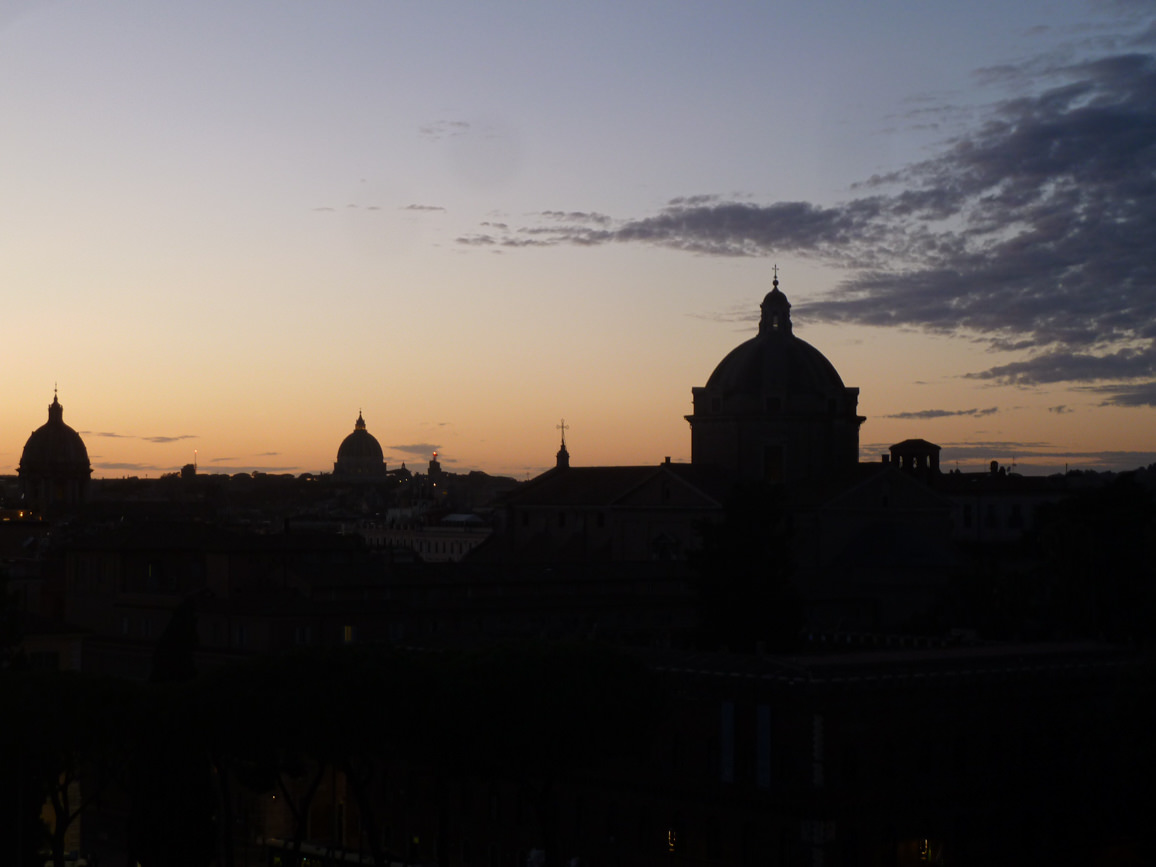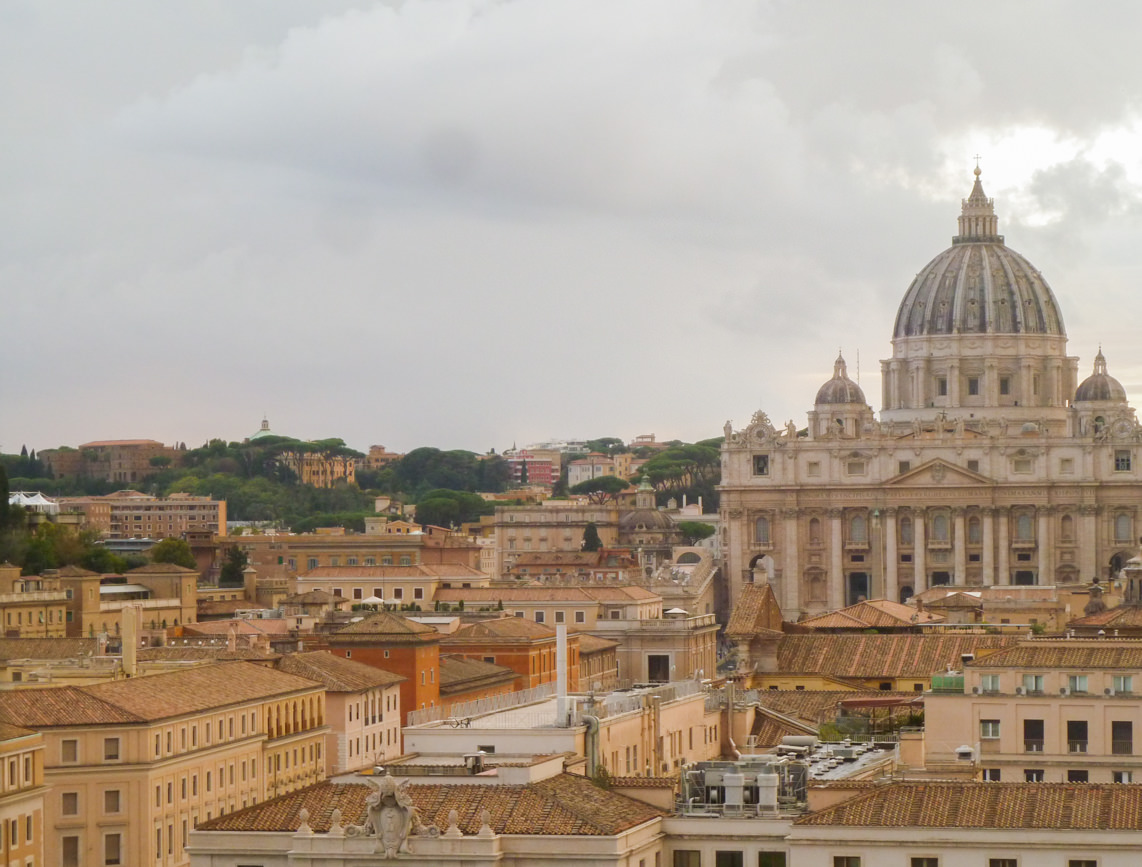
Rome, the Italian capital, is a fascinating city with so many things to see and do that it could literally take you a lifetime to cover it all. To keep it simple, I´ve prepared this Rome travel guide so you know exactly what to see and do, where to eat and sleep and how to get around the Eternal City. At the end of this post, I´ve included a map with all the locations mentioned throughout this post.
What to see and do in Rome
First things first, let’s start with the basics before digging into what you can see and do in Rome.
When walking around the Roman city, you will notice marble plaques in the corners of many buildings with the word ‘rione‘, a number, a name and a coat of arms. Rione (or rioni in plural) refer to the districts of Rome. Although the number of rioni has varied over time, there are currently 22 rioni. Some famous rioni include Borgo, Prati, Monti or Trevi, to name just a few.
On a similar note, you might have heard about the legendary seven hills of Rome on which the ancient city that once ruled the world was originally built: Palatine, Capitoline, Quirinal, Viminal, Esquiline, Caelian, and Aventine. According to legend, the founding of Rome occurred in the year 753 BC. The twins Romulus and Remus, sons of Mars and a vestal virgin, were abandoned by their uncle and nursed by a she-wolf. They founded rival cities in the Bronze Age in the Palatine Hill, but Romulus killed Remus after an argument and his city (Rome) was the one that would later achieve fame and glory.
Given the endless things of see and do in Rome, I’ve decided to sort the content by categories (from basilicas and churches, to museums, parks, squares, panoramic views, and even places off the beaten path). Feel free to jump directly to the section that sounds more appealing to you.
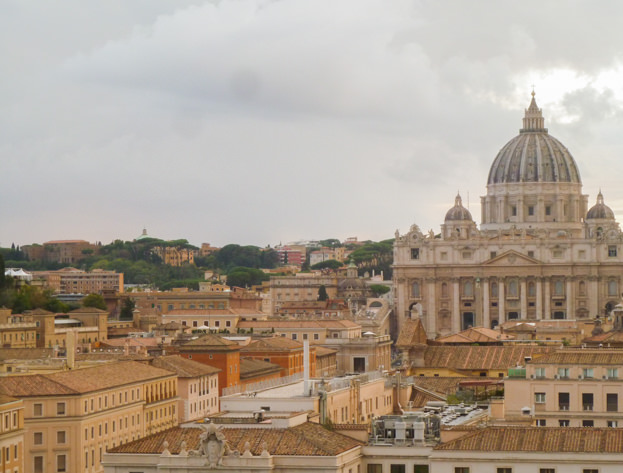
Basilicas and churches
Given the vicinity of Rome and the Vatican City and the influence of the latter for centuries, the Italian capital is one of the main religious centers around the world. That is why you will run into church after church when strolling the Roman streets. It would be challenging to describe them all, but first let’s distinguish between a basilica and a church.
When it comes to basilicas, there are two types: basilicas major and basilicas minor. Basilicas major are located in and around Rome and are given that title by the Pope. They usually have historic significance and are honored by a saint. Here’s a list of the four major basilicas that deserve being on your bucket list when visiting Rome:
- Basilica of Saint Peter in the Vatican (San Pietro in Vaticano)
The Papal Basilica of Saint Peter is one of the landmarks in Vatican City, not only because of its massive size but also given its religious and artistic significance. These are the essentials you should cover during your visit to St Peter’s Basilica: the statues of Pietà by Michelangelo and St Peter by Arnolfo di Cambio, the Baroque baldachin by Bernini, the Treasury, St Peter’s tomb and the dome. Make sure to climb to the dome of St Peter’s Basilica for breathtaking panoramic views of Vatican City and Rome!
- Basilica of Saint John in Lateran (San Giovanni in Laterano)
San Giovanni in Laterano is the cathedral of the bishopric of Rome. Founded in the 4th century by Constantine, Saint John in Lateran was the main papal residence until 1309 and the popes were elected here until the 19th century. The main features worth mentioning in this basilica are its baptistery (said to be the first one in the world), its exceptional cloisters from the 13th century, and the holy ladder (Scala Santa) that supposedly Jesus climbed in the house of Pontius Pilate to face his trial and that was brought from Jerusalem by Saint Helena, wife of Emperor Constantine. On another note, Labor Day is celebrated on May 1st (Primo Maggio) with a massive and free concert in front of the basilica.
- Basilica of Saint Mary Major (Santa Maria Maggiore)
Santa Maria Maggiore is one of the largest basilicas in Rome and houses a unique mix of architectural styles, ranging from the Byzantine period, to the medieval, Renaissance and Baroque eras. This church dates back to the 5th century, as do its oldest mosaics full of Byzantine splendor. Pope Sixtus V chose the Egyptian obelisk in 1587 as part of his general urban plan to provide a place of reference for pilgrims.
- Basilica of Saint Paul Outside the Walls (San Paolo fuori le Mura)
San Paolo fuori le Mura is the second largest church in Rome and was built by Constantine in the 4th century where Saint Paul was buried. The splendid interior features some mosaics from the 5th, 12th and 13th centuries along with the authentic bronze door dating from the 11th century and a large chandelier. The double-columned cloisters of 1214 are considered the most beautiful in Rome and fortunately escaped a ravaging fire in 1823.
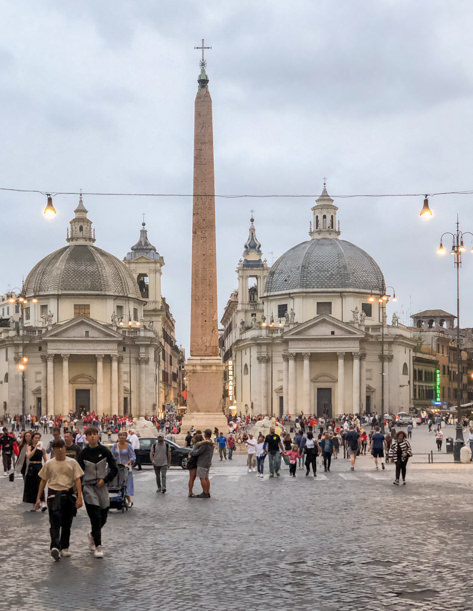
Turning to famous churches in Rome worth visiting, the list is also endless but my suggestions would be the following:
- Santa Maria del Popolo: this imposing church built on the tombs of Roman emperors, offers one of the richest samples of Renaissance and Baroque art in Rome with works by Pinturicchio, Raphael, Caravaggio and Bernini.
- San Clemente
- Santa Maria sopra Minerva
- Santa Maria in Trastevere
- San Luigi dei Francesi
- Sant’Andrea della Valle
- San Pietro in Vincoli, housing the renowned Michelangelo’s Moses
For a full list of the churches and basilicas in Rome, you may refer here.
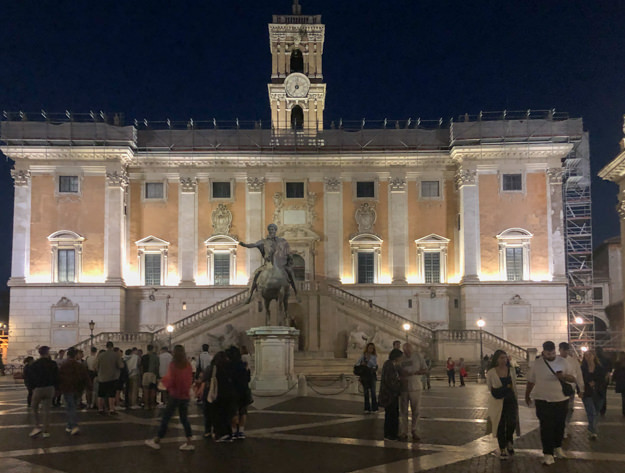
Museums and galleries
Given its long history, Rome hosts numerous museums and galleries with priceless treasures and monumental art pieces. Below is a selection of the top 10 you should see in Rome:
- The Vatican Museums (Musei Vaticani)
These are an essential stop when visiting Vatican City. This gigantic complex houses numerous museums and some of the most remarkable art pieces. Note that the Vatican Museums are free the last Sunday of every month, with shorter opening hours and provided that it doesn’t coincide with some specific dates. If your schedule allows, try to plan your visit around a Sunday!
Listed here are the top 10 highlights that I would recommend checking out during your visit to the Vatican collections: the Sistine Chapel, Raphael’s Rooms, Apollo Belvedere, the Transfiguration by Raphael, the Chapel of Nicholas V, the Laocoon or Laocoön, Caravaggio’s Deposition of Christ, the Borgia Apartment, the Belvedere Torso, and Leonardo da Vinci’s St Jerome. Read my post ‘12 things to see and do in Rome‘ for more information.
- The National Roman Museum (Museo Nazionale Romano)
Founded in 1899, its works include antiquities and archaeological remains found since 1870, in addition to pre-existing collections. The pieces are separated into four locations throughout the city of Rome: Baths of Diocletian, Palazzo Massimo, Palazzo Altemps and Crypta Balbi.
- Galleria Borghese, Villa Giulia, Galleria Nazionale d’Arte Moderna
Despite housing different collections, these three galleries are located in Villa Borghese, the largest park in Rome.
While the Galleria Borghese features Renaissance and Baroque art including sculptures by Bernini and paintings by Caravaggio, the Museo Nazionale etrusco di Villa Giulia houses ancient Etruscan artifacts (the most notable being the terracotta Sarcophagus of the Spouses dating from the 6th century BC). Finally, the Galleria Nazionale d’Arte Moderna displays contemporary art from Rodin, Cézanne, Modigliani or Van Gogh among others.
- The Capitoline Museums (Musei Capitolini)
The twin palaces of Palazzo Nuovo and Palazzo dei Conservatori in Piazza del Campidoglio form the neighboring Capitoline Museums, which house ancient sculptures, statues and paintings. Some of the works worth mentioning are the equestrian statue of Marcus Aurelius, the dying Gallic or the mosaic of the pigeons.
This state collection is divided between two noble residences (Palazzo Barberini and Palazzo Corsini), where you will find art pieces by El Greco, Caravaggio, Rubens or Van Dyck.
This palace belonging to an aristocratic family exhibits masterpieces by, among others, Rafael, Tiziano and Velázquez.
Housed in the homonymous palace of the 16th century, this gallery displays the Cardinals’ collection with works from the Baroque, Renaissance and later periods with paintings by Rubens and Jan Brueghel the Elder. One of the highlights is the fantastic gallery with trompe-l’oeil by Borromini.
Having started with a small donation to the city in 1833, this collection has grown to include samples from all the important Italian art movements of the 19th and 20th centuries. There are canvases by De Chirico, Morandi and Afro as well as sculptures.
For further details on museums in Rome, you can browse this page.
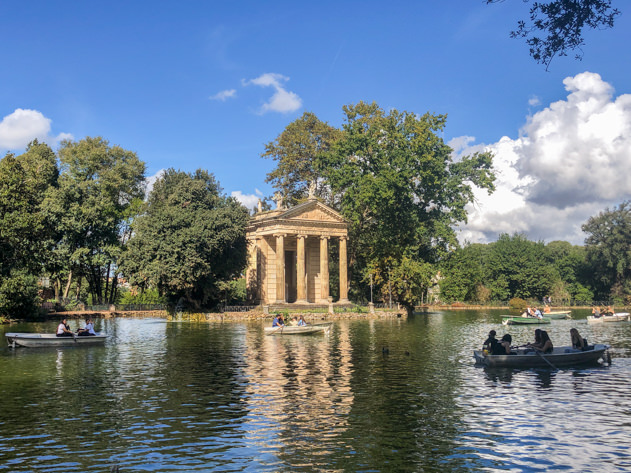
Parks and gardens
Take a break from the bustling city and enjoy idyllic environments in the middle of nature in these Roman parks and gardens. By the way, some of these parks feature wonderful panoramic views of Rome, so take advantage of that while enjoying outdoors!
- Villa Borghese
Spanning over 688 hectares, Villa Borghese is the largest park in Rome. Back in 1608, Cardinal Scipione Borghese converted these family grounds into a private park, which was then open to the public in 1901. Currently, these vast public gardens house sculptures, fountains, groves, paths, pavilions and even a water clock, making it the perfect location for running, riding a bike, a relaxed walk, a picnic or paddling on the lake. During my most recent visit to Rome, I rented an electric bike with Uber. Although I found it expensive – I paid around 25 EUR for less than 2 hours – the experience was memorable! When visiting Villa Borghese, you can stop by one of its various museums (see section above), paddle a boat in the lake by the Temple of Aesculapius or admire the panoramic view of Piazza del Popolo and beyond from the Pincio terrace (see section on panoramic views afterwards).
Given its size, I highly recommend biking instead of walking in order to cover most of Villa Borghese in a shorter period of time.
- Villa Celimontana: jazz concerts typically take place here during the summer months.
- Villa Doria Pamphilj: this is the largest green area in Rome, covering from the Gianicolo along the ancient Via Aurelia. Its hills are adorned with villas, fountains, lakes and orange trees and are ideal for having a snack under the pine trees or for running.
- Botanical Garden (Orto Botanico): the beautiful gardens of the Corsini Palace are a fantastic spot to enjoy free time and breathe air scented by more than 7.000 exotic and local botanical species grouped by ecosystems. The gardens belong to the University of Rome.
- Villa Sciarra: this small park is full of fountains, ponds, logias and statues. There are trails to walk and grass to lie on. It is also suitable for children!
- Villa Ada: originally the hunting preserve of Italian king Victor Emmanuel III, this immense park has rolling fields, serene waters and groves of trees on summer nights. The lake at one end hosts food stalls and concerts.
- Piazza Benedetto Cairoli: it is one of the newest parks in Rome. Sit on a bench surrounded by flowers and the gentle murmur of water from the fountains to pretend you’re in a remote island (in the middle of a bustling neighborhood).
- Colle Oppio: you can admire the Forum, the Colosseum and the scattered remains of Trajan’s baths from these green hills. The largest area of the park actually corresponds to the roof of Nero’s golden house.
- Parco della Resistenza dell’Otto Settembre: this ancient wasteland has been converted into a pleasant green area where Romans eat outdoors and play with their children.
- Parco Mellini: located near the Rome Observatory in Monte Mario, this park and its panoramic viewpoint offer a different perspective of looking at the city of Rome, its surrounding hills from the northwest and even Colli Albani.
- Rose and Orange Gardens: There are certainly plenty of locations featuring breathtaking viewpoints of the Italian capital, but one of my all-time favorites is Giardino degli Aranci (the Orange Garden). Located on top of a hill near the Circo Massimo, you will first pass by the Rose Garden, a place radiating beauty specially during the spring and summer months.
For further information on parks and gardens throughout Rome, you can check this page.
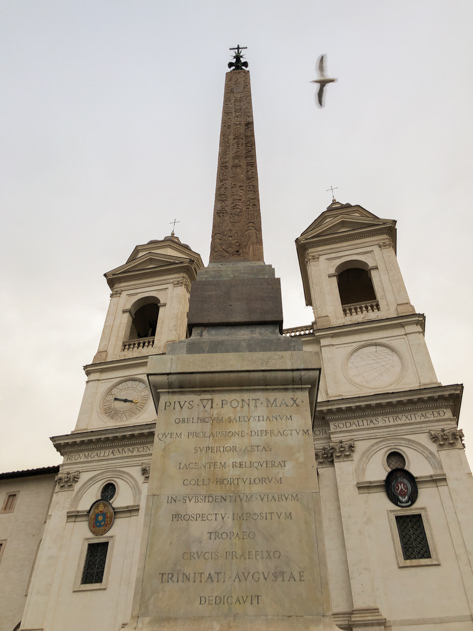
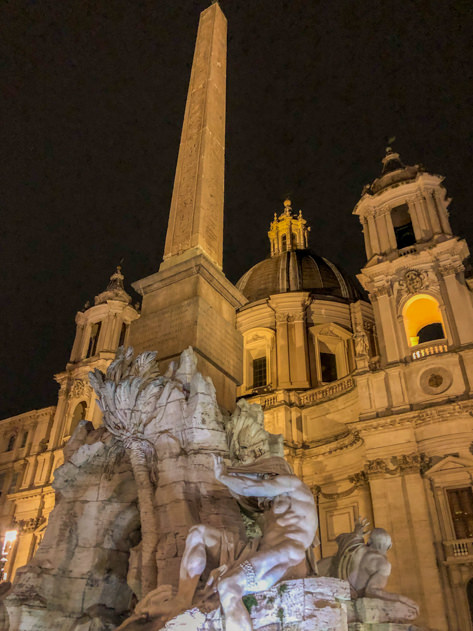
Squares and fountains
Rome is a lively city and you can enjoy it at its best, be it day or night, by strolling around its beautiful squares. Listed below are the ten most popular Roman squares and fountains:
- Campo de’ Fiori
Literally meaning the field of flowers, this square shines with color during the morning market and again at night when its bars make it the center of Roman nightlife. The austere statue of the hooded man is in honor of Giordano Bruno, a theologian burned alive for his progressive heresies during the Counter-Reformation.
- Piazza del Popolo
This monumental square is beautifully symmetrical. Between 1811 and 1823, the architect Giuseppe Valadier turned this place of festivals and public executions into an elegant square by adding four fountains with lions to the base of one of the oldest obelisks in Rome. Next to the Porta del Popolo (formerly known as Porta Flaminia) lies the imposing church of Santa Maria del Popolo. Built on the tombs of Roman emperors, it offers one of the richest samples of Renaissance and Baroque art in Rome with works by Pinturicchio, Raphael Caravaggio and Bernini. You will find the twin churches of Santa Maria dei Miracoli and Santa Maria in Montesanto, built next to each other, in the other end of the square. Finally, three major streets (known as Tridente by the locals) depart from Piazza del Popolo: via del Corso, via Ripetta and via del Babuino.
- Piazza di Spagna
This is one of the most famous squares in Rome, and it owes its name to the nearby Spanish Embassy. It features an hourglass shape. Three elements stand out in Piazza di Spagna: the staircase (Scalinata della Trinità dei Monti, also known as Spanish Steps), Chiesa della Trinità dei Monti and La Barcaccia (a fountain depicting a sinking boat). After visiting Piazza di Spagna, you may wish to go shopping (or at least window-shopping) along Via Condotti. This is where the Italian luxury brands such as Armani, Bulgari, Gucci or Prada display their expensive products in fabulous stores.
- Fontana di Trevi
Thanks to the world of cinema, this fountain is one of the best-known images of Rome and probably the most popular attraction in town. Always crowded with tourists at any time of the day or night, the absolute beauty and power of this creation is truly captivating. Built in 1732 by Nicola Salvi and attached to the back of a palace, this majestic fountain marks the end of the Acqua Vergine aqueduct built by Agrippa in 19 BC from a source miraculously discovered by a virgin. When paying a visit to the Fontana di Trevi, don’t forget to throw a coin with your back to the pool. Legend has it that if you do so, you will return to Rome! But rest assured, the coins are collected every morning. 🙂
- Piazza Navona
The elongated oval of the most charming of Rome’s squares hints that it was built on the ancient stadium of Domitian. This pedestrian paradise is full of cafes, street performers, tourists and splashing fountains. Piazza Navona is surrounded by magnificent Baroque buildings such as Palazzo Pamphilj (now housing the Brazilian Embassy) or the church dedicated to Sant’ Agnese. The three fountains located in Piazza Navona are even more impressive: Fontana del Nettuno, Fontana dei Quattro Fiumi, Fontana del Moro.
- Saint Peter Square (Piazza di San Pietro)
The imposing St Peter’s Square at the end of Via della Conciliazione marks the starting point to the grandiosity of the Vatican. Bernini’s extraordinary semi-elliptical colonnades transformed the approach to the basilica into a pair of welcoming arms that envelop the believer. The obelisk comes from the Egyptian city of Alexandria.
- Fontana delle Tartarughe
Giacomo della Porta designed this delightful fountain between 1581 and 1584. The turtles fighting over the edge are an addition from 1658, probably by Bernini.
- Piazza Barberini
The Triton Fountain, with a triton expelling water from a shell, lies at the center of this bustling square. It was designed between 1642 and 1643 by Bernini and commissioned by Pope Urban VIII.
- Piazza Venezia
This square is the de facto center of Rome and the confluence of its traffic routes. The square is flanked by the Palazzo Venezia from which Mussolini instructed the hordes during the fascist period.
- Fountain of the Naiads
This gigantic fountain expels large jets of water. The fountain,sculpted in 1888 by Mario Rutelli, is surrounded by naiads and horses.
- Piazza Santa Maria in Trastevere
This neighborhood square is flanked by cafes, shops, restaurants and a 17th century palace next to a medieval church with mosaics illuminated at night. A fountain adorned with shells by Carlo Fontana on a pedestal of stairs is popular with local musicians and tourists alike.
You can find the full list of parks and gardens of Rome in this page.
Check out these posts with additional inspiration about Rome!
12 things to see and do in Rome
The best panoramic views of Rome
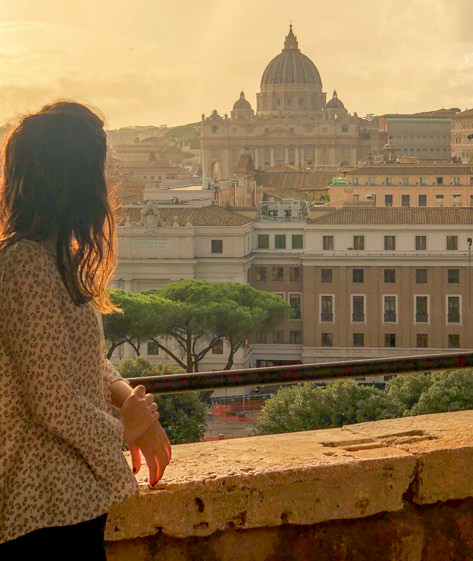
Panoramic views
There are plenty of locations featuring breathtaking viewpoints of the Italian capital. Listed below is my own compilation of 11 Roman viewpoints to admire the Eternal City:
- Terrazza del Pincio
- Piazza della Trinità dei Monti
- La Rinascente in via del Tritone
- Vittoriano (Monumento a Vittorio Emanuele II)
- Campidoglio
- Terrazza Caffarelli in the Musei Capitolini
- Terrazza Belvedere Aventino
- Belvedere del Gianicolo
- Castel Sant’Angelo
- Dome of St Peter’s Basilica
- Parco Mellini
For further information on each of these viewpoints, you can read my post about the best panoramic views of Rome.
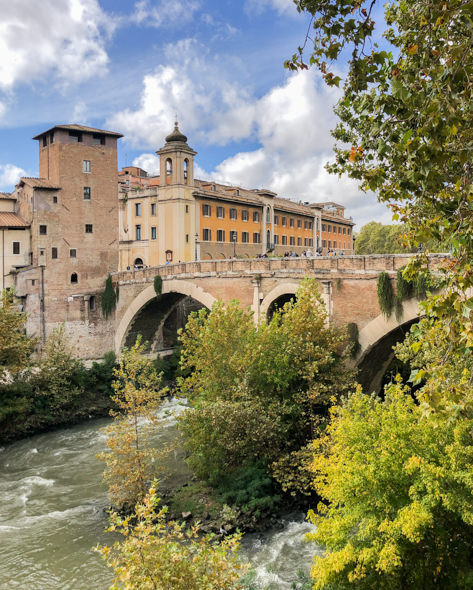
Exploring beyond the Roman beaten path
As you can see, there are plenty of popular spots you should cover when visiting Rome. However, it’s also a good idea to explore other areas that are less known, be they inside the Roman city walls, beyond them, or even throughout the Lazio region or Italy in general. Ready to venture off the beaten path to avoid the crowds?
Rome intramuros
- Testaccio
The district of Testaccio (rione XX) is a popular neighborhood in southern Rome, housing some delicious restaurants such as Checchino dal 1887, which is the birthplace of ‘coda alla vaccinara‘ (braised oxtail with celery and tomato broth). Unsurprisingly, it is located right next to the slaughterhouse (Mattatoio), where the Testaccio Village festival is held every summer. Another nearby attraction in Testaccio is the pyramid of Caius Cestius (Piramide), built with brick and then covered with marble in 12 BC as part of the defensive walls of the city following the Egyptian fashion.
- Isola Tiberina
Either if you’re heading towards the Trastevere district or to admire Bocca della Verità in Santa Maria in Cosmedin in the opposite direction, I recommend you stop by this tiny island housing a hospital, various churches and restaurants. It has great views over the Tiber river.
Rome extramuros
Although the best of Rome lies within its walls, venturing outside the 3rd century Aurelian Wall is worth it. Detailed below are some must-sees for anyone who wants to leave the Roman city center:
- Catacombs: outside the Roman city walls you will find a number of ‘catacombs’, which were former underground burial grounds. The most famous ones include the Catacombs of Domitilla (this is the biggest network), Saint Sebastian and Saint Callixtus (the first official Catholic cemetery of Rome).
- Churches beyond the Roman walls: San Paolo fuori le Mura is the second largest church in Rome and was built by Constantine in the 4th century where Saint Paul was buried. On a similar note, the churches of Sant’Agnese fuori le Mura and Santa Costanza are located in the same pre-Christian complex and feature sublime mosaics from the 4th century.
- EUR: this vast area was built by Mussolini on the occasion of the Universal Exposition of Rome, which never actually took place because of World War II. Showcasing an ideal fascist metropolis, the main highlights include the Palazzo della Civiltà del Lavoro and the Museo della Civiltà Romana.
- Ostia Antica: this was the main port during Roman times and a bustling commercial center. The extraordinary ruins of Ostia Antica provide an insight into life in ancient times, the main attractions being the Decumanus Maximus (the main avenue), the Theater, the Forum, the Capitol, two sets of baths (Terme dei Sette Sapienti and Terme di Nettuno) and even a Thermopolium (the equivalent of a bar with a marble counter and paintings advertising food and drinks). You can also stop by the Museum located in the archaeological park. You can easily reach Ostia Antica by train from the Roman station of Porta San Paolo, near Piramide.
- Via Appia Antica: the first section of this road connecting Rome to its Eastern empire was built in 312 BC. It is flanked by family tombs, monuments and common graves known as columbaria. Along via Appia Antica lies the church of Domine Quo Vadis?, which marks the place where Saint Peter is said to have encountered Christ while fleeing Rome. Sunday is the best day to visit Appia Antica as it is closed to traffic.
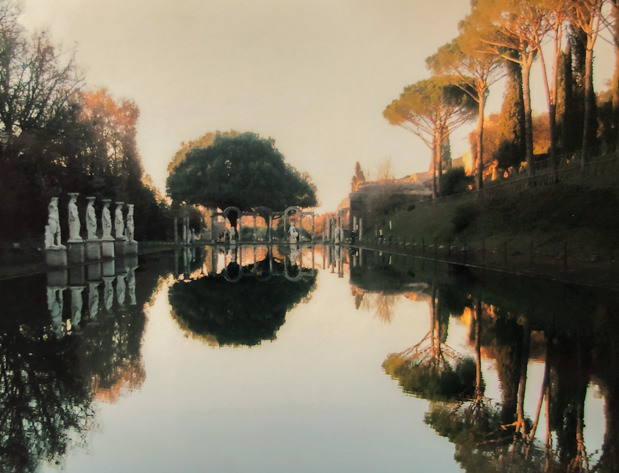
Lazio region
Surrounding the capital city of Rome, the Italian region of Lazio is also worth visiting. Here are some ideas:
- Castelli Romani: this area encompassing hills and lakes was already popular in Roman times. It is dotted with fortified castles and luxurious residences with spectacular parks and gardens. For example, the Castel Gandolfo, the Pope’s Summer Palace, overlooks Lake Albano.
- Cerveteri: the necropolis of this city dating from the 6th century BC is almost intact and full of streets, houses, frescoes and burial mounds known as tumuli.
- Tivoli: It is probably the most popular excursion from Rome. The main attractions in this mountainous city include the magnificent Villa d’Este, built for a cardinal in the 16th century, and Villa Adriana, which was built as the emperor’s summer retreat between 118 and 134 AD and includes reproductions of his favorite buildings.
- Viterbo: this was an important Etruscan center before falling to the Romans in the 4th century BC. Within the walls of this medieval town you will find a Papal Palace, the Archaeological Museum and the Fontana Grande (big fountain).
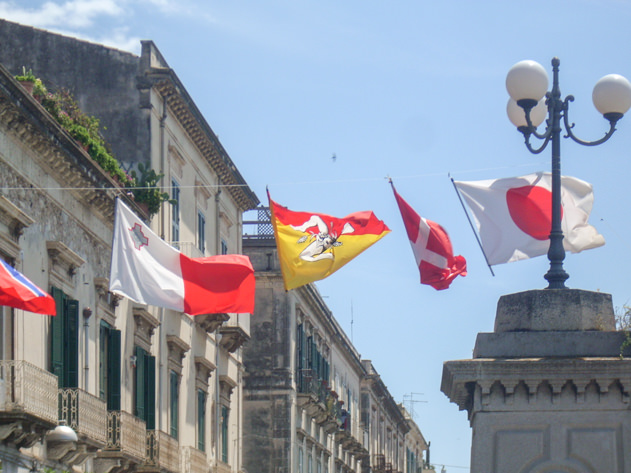
Visiting Italy
If you’d like to read more content about Italy, you will find some related links below:
- Italy destination page: your go-to place with basic facts about the country, things to do, food and much more. It also includes all my posts on other Italian destinations such as Sicily.
- Make sure to check out my Italy folder on Instagram including stories of my most recent trip to Rome.
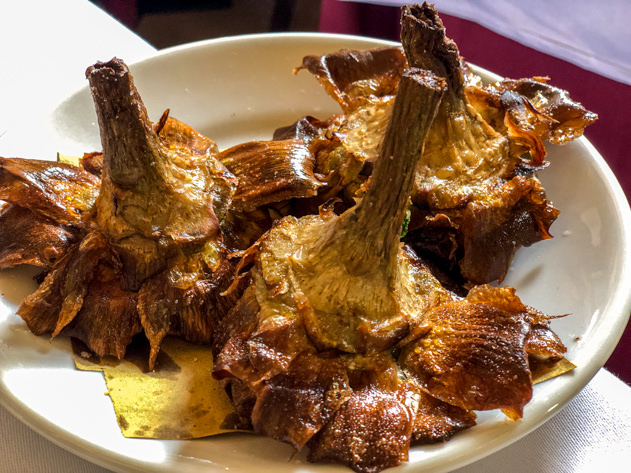
Where to eat in Rome
Typical Roman dishes
Rome is a paradise for food lovers. The city offers endless cafeterias, ice cream parlors and restaurants to choose from.
Here’s a list of the most classical dishes in Roman cuisine that you may encounter during your visit to the Italian capital:
- Supplì: this croquette filled with rice, tomato, meat and mozzarella is typical from the Lazio region. It is similar to the Sicilian arancini.
- Saltimbocca: beef escalope with sage and ham sautéed in white wine.
- Bucatini all’ amatriciana: pasta with a tomato sauce and bacon seasoned with pepperoni and generously sprinkled with grated pecorino cheese. If you remove the tomato sauce, it would be called pasta alla gricia.
- Carciofi alla romana or alla giudia: while the first type of artichokes (alla romana) are seasoned with garlic and mint braised in a mixture of olive oil and water, the second type (alla giudia) are crushed and then fried.
- Abbacchio scottaditto: roast lamb.
- Porchetta: emptied, boned and stuffed pork with aromatic herbs, salt and pepper, roasted in the oven. It is eaten sliced, generally in street food stalls. Visit Ariccia, in the Lazio region, to eat the best porchetta.
- Spaghetti alla carbonara: pasta served with egg yolk, grated parmesan cheese, black pepper and bacon.
- Pajata: pasta served with a tomato sauce and calf intestines cooked in breast milk.
- Coda alla vaccinara: braised oxtail with celery and tomato broth.
- Gnocchi alla romana: potato and butter balls that can be served with a variety of sauces.
- Cacio e pepe: spaghetti with ground black pepper and grated pecorino cheese.
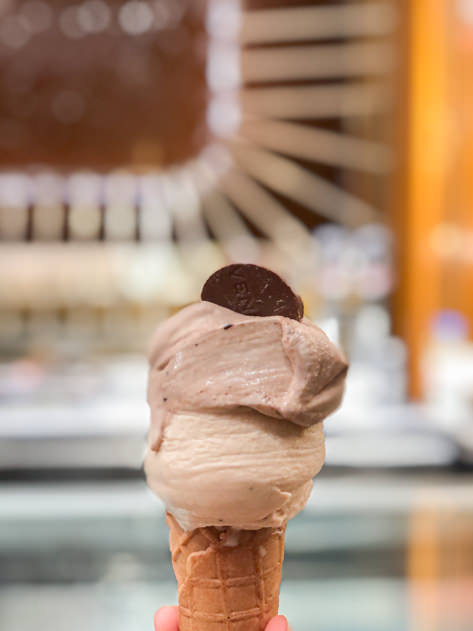
Best cafeterias, ice cream parlors and restaurants in Rome
Below is a list of the places I tried during my last visit to the Italian capital, sorted by cafeterias, ice cream parlors and restaurants. Enjoy la dolce vita! 🙂
Cafeterias
- Allegrío: we had a delicious cappuccino and cornetto (croissant) in this fancy cafeteria / lounge bar / restaurant located in Via Veneto. Although it was on the expensive side, their coffee was out of this world and the interior design was worth checking out too.
Ice cream parlors
- Gelateria della Palma: this used to be my favorite ice cream parlor during my Erasmus exchange program in Rome back in 2007-2008. It is ideally located close to the famous Pantheon and features 150 flavors. This time around I tried frutti di bosco (wild fruits) and cioccolato all’arancia (chocolate with orange).
- Venchi: this Italian company renowned for its chocolate originated in the northern region of Piedmont. They have various stores around Rome. We stopped at their fancy branch in Via del Corso, where I ordered an ice cream with mango and Piedmont hazelnuts. Yum!
Restaurants
- Osteria delle Coppelle: we ordered insalata tiepida and a pizza di strecchino, speck, rucola e brulé di vino rosso in this cute restaurant with outdoor seating located in a charming square steps away from the Pantheon.
- Trattoria Da Teo: popular restaurant in Trastevere among locals and tourists alike. We enjoyed eating their delicious artichokes (carciofi alla giudia) and the ravioli ricotta e spinaci. The tiramisù for dessert was really good too.
- Momart Café: we came here for the ‘aperitivo‘, an Italian tradition that usually takes place around dinner time. You typically pay for the drink only (in this case it was 14 EUR) and the food and desserts are served in a buffet-style ‘all you can eat’. The place was packed with people from all ages and we had to wait a while to get in, but it was worth it. Their pizzas cooked in a wood-fired oven were hands down the best ones I tried during my Roman trip. The only downside is that it is a bit far away from the city center.
- Checchino dal 1887: considered one of the best restaurants in the city of Rome, this is the birthplace of ‘coda alla vaccinara‘ (braised oxtail with celery and tomato broth). Unsurprisingly, it is located in the Testaccio district, right next to the slaughterhouse (Mattatoio). We ordered a platter of four Italian cheeses as a starter, followed by coda alla vaccinara and trofie al pesto di rucola e mandorle con pecorino. We had panna cotta con salsa al caramello for dessert.
- Antica Osteria di Pietra: on our last day in Rome, we ordered a pizza capricciosa from here and decided to eat it while admiring the Fontani di Trevi and people-watching. How cool is that?
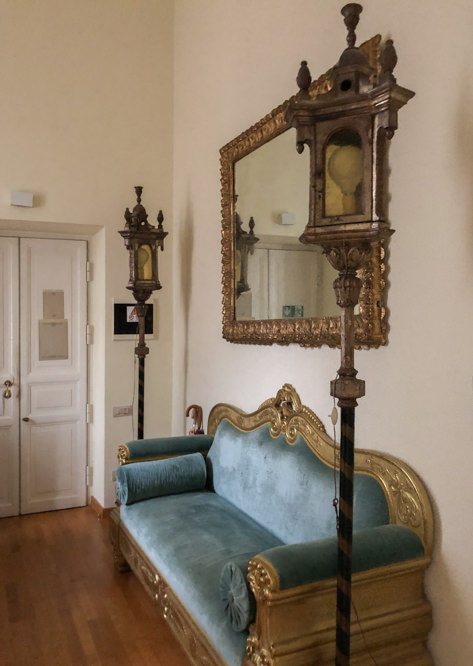
Where to sleep in Rome
As you can imagine, there’s no shortage of options to sleep in Rome. However, prices may obviously vary depending on your budget.
- $$$: if you’re looking for luxurious hotels, you can stay at the Hassler, the Majestic or Hotel de Russie. This page shares a long list of historic hotels in Rome.
- $$: in case your budget is moderate, you may sleep at Hotel Condotti, the boutique hotel Sole al Pantheon, or hotel Santa Maria in Trastevere. During my most recent visit to Rome, we booked this accommodation at All’ Obelisco (Via Gregoriana 25). Its location a few steps away from Piazza della Trinità dei Monti and Piazza di Spagna is hard to beat, and the self-service breakfast was good. The only downside was that the bathroom was a bit outdated and the walls were really thin, so you could hear other guests as if they were in your room.
- $: cheaper accommodation options in Rome include hotel Sant’Anna, hotel Carmel Trastevere or Casa di Santa Brigida.
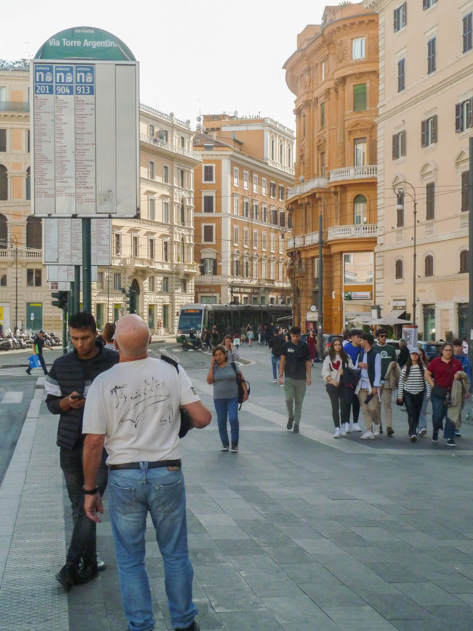
How to get around Rome: transportation tips
There are various ways of getting to and around Rome, so here’s a breakdown of each of them depending on the transportation of your choice when visiting the city.
Airports
The two main airports in Rome are Fiumicino (also known as Leonardo da Vinci) and Ciampino.
Located 32km west of Rome, Fiumicino is the largest airport welcoming most international flights to the Italian capital. The train Leonardo Express departs every 15 minutes, connecting the airport of Fiumicino with the train station of Roma Termini in around 30 minutes. The ticket costs 14 EUR one way. You can browse other ways of getting to and from Fiumicino here.
On the other hand, the smaller airport of Ciampino is located 15km south of the city of Rome. Check out how to get to and from Ciampino here.
During my Erasmus exchange year, I usually flew from Santander to Rome Ciampino, but the last time I visited in October 2023, we flew to Fiumicino.
Metro
There are three metro lines in Rome (A, B and C) managed by ATAC. Lines A and B intersect in Roma Termini, the central train station.
Using the metro in the Italian capital is straightforward and helpful when covering big distances. Beware of the pickpockets though!
For your ease of reference, you can check this map displaying the metro, urban and regional railway lines of Rome.
For tickets and passes, you may refer to this page. Pick the best option depending on the length of your stay (24h, 48h or 72h) and whether or not you also plan on visiting any museums, archaeological sites or experiences.
Bus
There are plenty of bus lines that can get you around Rome if you don’t feel like walking all the time. Note that the traffic in the capital can be heavy, specially at rush hours, although it’s definitely a great and cheap way of sightseeing!
You can purchase your ticket at shops, kiosks or machines. The ticket usually lasts 90 minutes since you print it the first time and you can use other means of transportation in that time frame.
In case you’re looking for touristic buses from which you can hop on and off at your convenience while listening to an audio guide, you may check out these companies: Big Bus Tours, Roma City Tour, or City Sightseeing.
Taxi
Taxis are another great way of getting around Rome, although I’ve typically used them at night during my Erasmus exchange year or to go to the airport.
I remember taxi drivers cheating on foreign clients quite often back in the day, so make sure you know where you’re going and approximately how much the route would cost in order to avoid unpleasant surprises. If needed, ask beforehand at an information point.
However, the last time I visited Rome, we used itTaxi (+39063570), which came recommended by our hotel host. We booked a taxi in no time, we received a confirmation SMS, and the taxi driver who drove us to Fiumicino airport very early in the morning was extremely kind. I would definitely use this service again if I had to order a taxi in Rome or in some other Italian city!
Bikes
Given the dangerous traffic in the Roman capital, I don’t think it’s safe enough to bike around the streets of Rome. But pedaling in a park can be a good alternative. During my most recent visit to Rome, I rented an electric bike with Uber to explore Villa Borghese. Although I found it expensive – I paid around 25 EUR for less than 2 hours – the experience was memorable! Furthermore, it allowed us to cover most of the park relatively quickly.
By foot
I believe that Rome is best explored by foot. Even if it’s a big city, you can easily go from one place to another by taking the metro (usually faster) or a bus (usually slower because of the heavy traffic, but at least you get to see the lively city).
Having said that, be extremely cautious when walking around as Italians are infamously known for their reckless driving. When it is possible, walk on the sidewalk (many streets don’t even have one or are very narrow) and avoid crossing at a red light.
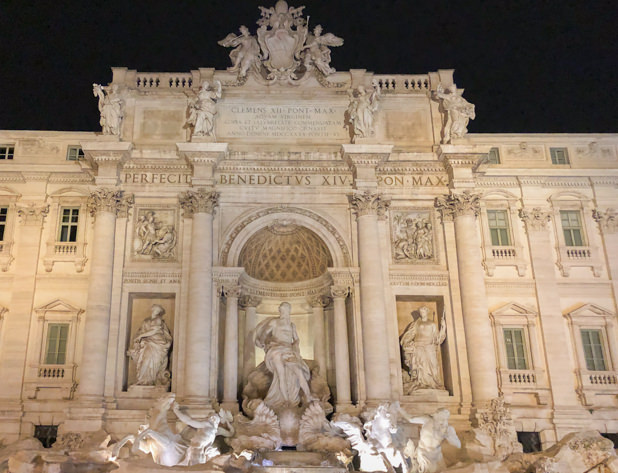
Map with all the Roman locations mentioned throughout this travel guide
In the map below you will find all the spots mentioned in this post, from iconic monuments, to restaurants, hotels and much more. Save it for your next trip!
How did you like this Rome travel guide? Was it helpful? Feel free to drop your questions and comments below.

